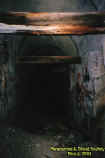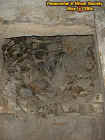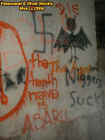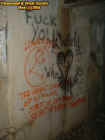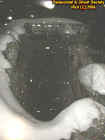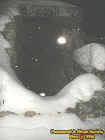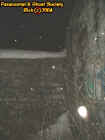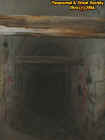|
|
||
|
On July 12, 1918 a munitions plant exploded at what is known today as Split Rock Quarry. That day 50 men were killed, over 100 injured, houses shook as many buildings were damaged within a half of mile radius. Fifteen of the men were never identified from the incident and today this quarry is one of the most haunted in the country. Some say that you can see glowing green and yellow figures standing on the stone crusher which is inside the cliff or on the quarries ledges. When the plant exploded the men were covered by picric acid which probably is why the ghost have a glowing greenish yellow skin. Since the quarry was a mining facility men of the men who died here were buried alive and burnt to death by the acidic explosion. I have wanted to visit here for a few years and was fortunate enough to explore the quarry before moving out of WNY. This has got to be one of the most frightening places I ever visited perhaps because here you have a quarry surrounded by cliffs, trails, miles of woods a place where the Onondaga Indians once roamed a place where a horrifying death occurred. But maybe its because I conquered this place alone something which gave me a sense of a major accomplishment not only for my members but something very few have achieved as I walked into a snowstorm into the darkness. But not only that but after careful research I read there are some places around the quarry actually shafts or holes that you could fall in and never been seen again. Some of these holes I read about are send to be so deep nobody knows how far they go down. So you can only imagine how I felt hiking threw 3 feet of snow knowing that one wrong step could lead to my own death or doom. Today the only thing that remains at the quarry is some stone foundations which were buried in snow and the stone crusher. The stone crusher sits within a limestone cliff with 2 very dark mine like tunnels. One of the tunnels veers off to the right and leads to a smooth arched tunnel but all the tunnels eventually lead to dead ends as the explosion has damaged or caved them in. But imagine your walking these dark tunnels not knowing what lurks deep underground or what lays at the end of these tunnels. So this was a very exciting investigation for me or rather intense. I mean you could spend hours just roaming the tunnels, exploring along the cliffs, and roads that lead to nowhere. There is alot of other oddities that probably add to the horror of this place not just the fact that there is many ghost. But that there is heavy signs of cult activity such as symbols on walls, candle wax, sticks of dynamite, alcohol bottles, demonic drawings on some of the cliffs and in the tunnel walls. So you can only imagine how when your deep inside the tunnel reading welcome to hell or how so and so creature will get you. The only regret I have is that I did not get to visit here during the day some say that during the day can be more haunted then at night. But in my opinion my visit had multiple supernatural occurrences such as footsteps, voices, cold spots, feelings of being watched as I looked up into holes in the ceiling going 50 feet above me. One of the most eeriest things is to walk close to the cliffs edge and on one side you have a cliff to your right and to your left you have a steep hill with woods so either way could lead to your own demise and now I am able to share my journey with you. Lastly as you know quarries are dumping grounds and areas used by cults. It is said some cults will use the quarry to revive ancient beast and mythological creatures so my opinion of this quarry is there is alot of sorrow and negative energies here perhaps due to the cult activity or maybe some evil practices. But also because what occurred here was a sickening accident some say that the German agents caused the explosion since by WWII the same company supplied 25 percent of the munitions. So the quarry played a big part in World War I unfortunately many were sacrificed so we must question a conspiracy or rather we ask was this truly an accident? But either way we must look at the fact that the quarry shaped the earlier years of WNY in the fact that much of the stone was used in the building of the Erie Canal, Aquaducts, Locks Etc. before the explosion by many hardworking Irish immigrants. So as you can see much history has occurred here and now for over 80 years split rock quarry remains alone, haunted, and mysterious as it is one of the greatest supernatural wonders in the country. You can read a little excerpt from a book about the Quarry about moments leading up to the giant explosion that shook the lands. © By Rick-AngelOfThyNight |
||
|
The Night the Rock Blew Up It was the night of Tuesday, July 2, 1918; the country was at war to end wars. Before the United States entered World War 1, the Semet Solvay Company at its Solvay plant manufactured in small lots picric acid for the French, English, and Italian governments. In the Fall of 1914, the Company accepted a million dollar order from Russia for trinitrotoluene, beginning the manufacture of TNT that continued throughout the next four years. With the order from Russia, the Company needed more space and a safer place for the operation than in the concentrated population of the village of Solvay. The Solvay Process Company was formed in 1881 for the manufacture of soda ash by a process combining limestone with salt. To obtain the limestone the Company acquired several hundred acres of privately owned quarries in Central New York, six miles west of Syracuse. By 1912 the Split Rock quarry was abandoned for a more productive one at Jamesville, leaving one thousand isolated acres only five miles from the village of Solvay. Semet Solvay engineers, carpenters, masons and patrolmen moved into the quarry. In April 1915, Split Rock Munitions plant was in operation in a portion of the unused quarry. Convenient transportation for the workmen was furnished by the Auburn Syracuse Electric Railroad. The tracks ran through the valley called the Gulf, which divided the munitions works into two sections "wet acid" in the quarries on the south, and "Canada" with its storage magazines and dry powder houses in the heavy wooded area between the Gulf and the West Genesee road on the north. Fourteen miles of protective fence surrounded the two sections, patrolled day and night by guards carrying 38 caliber Smith & Wesson revolvers. Eight watchtowers within sight of each other flashed revolving lights over the countryside.
Since the start of the manufacture of explosives at the Rock in April, 1915, Rigidly enforced safeguards lessened the chance of fire and explosion. Three hundred patrolmen trained in the technique of fighting munitions fires guarded the plant around the clock. Frequent drilling kept the patrolmen in fire fighting practice and they felt no great concern when the blast of the whistle split the early evening air. It might even be a fire drill . Team foreman William Brown continued to load the low flat wagons with the 100 pound boxes of wet acid to be taken over the dry bridge into Canada from the TNT building. Hearing the signal, workmen came running from the nitric acid building on the cliff. From a quarter of a mile away on the hill to the west, the men from picric plant looked down, saw the flames and knew this was no fire drill. From the acid recovery building ten men left their work to follow their leaders, "Come on, boys, let's get the chemical tank and go down and help them." Caused by an overheated gear in the grinding machine, the fire started in the monte jus room and spread to the 60 foot tower on the No. I TNT building. Forty men at work in the three TNT buildings manned their stations. Some used the hose, some fire extinguishers, and others used the chemical cart. At first the trained firemen kept the fire under control. When the roof of the tower burned through, a strong south wind fanned the flames, making a seething furnace of the 140 foot long building. In desperation more hose was attached, while the streams poured on the outside of the building seemed useless. Suddenly the hose went limp in the hands of the firefighters as the water pressure failed. They raced to close valves to bring water where it was most needed. Surely any minute the water would come with a rush. There might be an explosion if they couldn't stop this fire.
|
||
|
|
|







